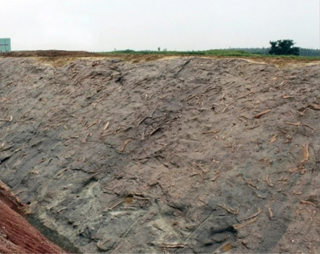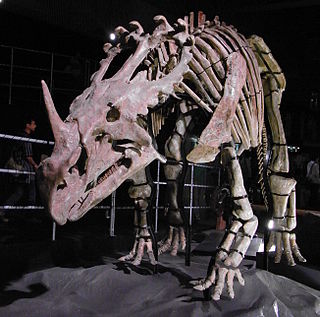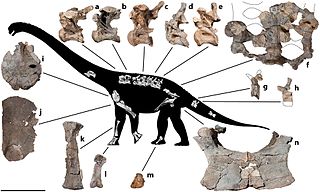
Saltasaurus is a genus of saltasaurid dinosaur of the Late Cretaceous period of Argentina. Small among sauropods, though still heavy by the standards of modern creatures, Saltasaurus was characterized by a short neck and stubby limbs. It was the first genus of sauropod known to possess armour of bony plates embedded in its skin. Such small bony plates, called osteoderms, have since been found on other titanosaurians.

Titanosaurs were a diverse group of sauropod dinosaurs, including genera from all seven continents. The titanosaurs were the last surviving group of long-necked sauropods, with taxa still thriving at the time of the extinction event at the end of the Cretaceous. This group includes some of the largest land animals known to have ever existed, such as Patagotitan—estimated at 37 m (121 ft) long with a weight of 69 tonnes —and the comparably-sized Argentinosaurus and Puertasaurus from the same region.

Nemegtosauridae is a family of titanosaurian sauropod dinosaurs based on their diplodocid-like skulls. Only three species are known: Nemegtosaurus, Quaesitosaurus and possibly Tapuiasaurus, each from the Cretaceous.

Shantungosaurus is a genus of very large saurolophine hadrosaurid dinosaur found in the Late Cretaceous Wangshi Group of the Shandong Peninsula in China, containing a single species, Shantungosaurus giganteus. The stratigraphic interval of Shantungosaurus ranges from the top of the Xingezhuang Formation to the middle of the Hongtuya Formation, middle to late Campanian in age. Shantungosaurus is so far the largest hadrosauroid taxon in the world, with size estimates around 15–17 metres (49–56 ft) in length and 13–16 metric tons in body mass.

Ampelosaurus is a titanosaurian sauropod dinosaur from the Late Cretaceous Period of what is now France. Its type species is A. atacis, named by Le Loeuff in 1995. Its remains were found in a level dating from 71.5 million years ago representing the early Maastrichtian.

Andesaurus is a genus of basal titanosaurian sauropod dinosaur which existed during the middle of the Cretaceous Period in South America. Like most sauropods, belonging to one of the largest animals ever to walk the Earth, it would have had a small head on the end of a long neck and an equally long tail.

Neuquensaurus is a genus of saltasaurid sauropod dinosaur that lived in the Late Cretaceous, about 80 million years ago in Argentina in South America. Its fossils were recovered from outcrops of the Anacleto Formation around Cinco Saltos, near the Neuquén river from which its name is derived.

Lirainosaurus is a genus of titanosaur sauropod which lived in what is now Spain. The type species, Lirainosaurus astibiae, was described by Sanz, Powell, Le Loeuff, Martinez, and Pereda-Suberbiola in 1999. It was a relatively small sauropod, measuring 4 metres (13 ft) long, possibly up to 6 metres (20 ft) long for the largest individuals, and weighed about 2–4 metric tons.

Sonidosaurus is a genus of sauropod dinosaur from the Late Cretaceous. It was a titanosaur which lived in what is now Inner Mongolia. The type species, Sonidosaurus saihangaobiensis, was described by Xu, Zhang, Tan, Zhao, and Tan in 2006. It was a small titanosaur, about 9 meters (30 ft) long. It was first discovered in the Iren Dabasu Formation in 2001 in a quarry which would later yield the remains of Gigantoraptor starting in 2005.

Saltasauridae is a family of armored herbivorous sauropods from the Upper Cretaceous. They are known from fossils found in South America, Africa, Asia, North America, and Europe. They are characterized by their vertebrae and feet, which are similar to those of Saltasaurus, the first of the group to be discovered and the source of the name. The last and largest of the group and only one found in North America, Alamosaurus, was thirty-four metres in length and one of the last sauropods to go extinct.

The Wangshi Group is a geological Group in Shandong, China whose strata date back to the Coniacian to Campanian stages of the Late Cretaceous. Dinosaur remains are among the fossils that have been recovered from the group.

Diamantinasaurus is a genus of titanosaurian sauropod from Australia that lived during the early Late Cretaceous, about 94 million years ago. The type species of the genus is D. matildae, first described and named in 2009 by Scott Hocknull and colleagues based on fossil finds in the Winton Formation. Meaning "Diamantina lizard", the name is derived from the location of the nearby Diamantina River and the Greek word sauros, "lizard". The specific epithet is from the Australian song Waltzing Matilda, also the locality of the holotype and paratype. The known skeleton includes most of the forelimb, shoulder girdle, pelvis, hindlimb and ribs of the holotype, and one shoulder bone, a radius and some vertebrae of the paratype.

Opisthocoelicaudiinae is a subfamily of titanosaurian dinosaurs from the Late Cretaceous. It was named by John McIntosh in 1990. Opisthocoelicaudiines are known from Mongolia, Argentina, and the United States. Two genera were assigned to Opisthocoelicaudiinae by Gonzalez et al. (2009): Alamosaurus and Opisthocoelicaudia, a conclusion also found by Díez Díaz et al. (2018). The hands of opisthocoelicaudiines lacked wrist bones and phalanges.

Sinoceratops is an extinct genus of ceratopsian dinosaur that lived approximately 73 million years ago during the latter part of the Cretaceous Period in what is now Shandong province in China. It was named in 2010 by Xu Xing et al. for three skulls from Zhucheng, China. The name of its type species Sinoceratops zhuchengensis means "Chinese horned face from Zhucheng", after the location of its discovery.

Zhuchengtyrannus is a genus of tyrannosaurid theropod dinosaur known from the Campanian stage of the Late Cretaceous of Shandong Province, China. It belongs to the subfamily Tyrannosaurinae, and contains a single species, Zhuchengtyrannus magnus.

Saltasaurinae is a subfamily of titanosaurian sauropods known from the late Cretaceous period of South America, India and Madagascar.

Patagotitan is a genus of titanosaurian sauropod dinosaur from the Cerro Barcino Formation in Chubut Province, Patagonia, Argentina. The genus contains a single species known from at least six young adult individuals, Patagotitan mayorum, which was first announced in 2014 and then named in 2017 by José Carballido and colleagues. Preliminary studies and press releases suggested that Patagotitan was the largest known titanosaur and land animal overall, with an estimated length of 37 m (121 ft) and an estimated weight of 69 tonnes. Later research revised the length estimate down to 31 m (102 ft) and weight estimates down to approximately 50–57 tonnes, suggesting that Patagotitan was of a similar size to, if not smaller than, its closest relatives Argentinosaurus and Puertasaurus. Still, Patagotitan is one of the most-known titanosaurs, and so its interrelationships with other titanosaurs have been relatively consistent in phylogenetic analyses. This led to its use in a re-definition of the group Colossosauria by Carballido and colleagues in 2022.
Lohuecotitan is an extinct genus of titanosaurian sauropod dinosaur which lived during the Late Cretaceous in Spain. The only species known in the genus is Lohuecotitan pandafilandi, described and named in 2016.

Savannasaurus is a genus of titanosaurian sauropod dinosaur from the Late Cretaceous Winton Formation of Queensland, Australia. It contains one species, Savannasaurus elliottorum, named in 2016 by Stephen Poropat and colleagues. The holotype and only known specimen, originally nicknamed "Wade", is the most complete specimen of an Australian sauropod, and is held at the Australian Age of Dinosaurs museum. Dinosaurs known from contemporary rocks include its close relative Diamantinasaurus and the theropod Australovenator; associated teeth suggest that Australovenator may have fed on the holotype specimen.
Sinankylosaurus is a genus of dinosaur, originally described as an ankylosaur, from the Late Cretaceous Hongtuya Formation of Shandong, China. The genus contains a single species, Sinankylosaurus zhuchengensis, known from a nearly complete right ilium. The describers claim that the discovery of Sinankylosaurus further demonstrates the similarity between dinosaurs of eastern Asia and western North America.




























